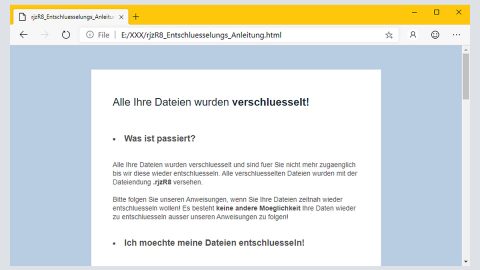What is PoisonFang ransomware? And how does it implement its attack?
PoisonFang ransomware is a newly discovered file-encrypting threat. It isn’t a typical ransomware as it contains advanced components that can cause widespread damage to the affected system. Based on the analysis done by security experts, PoisonFang does not belong to any ransomware group. Its ransomware engine is modular in nature which allows many components to be included in its default sequence of attacks.
Once it infects a computer, it uses a data harvesting module which is customized to extract strings that can reveal sensitive information of the computer and its user. The harvested data can then be used by another module in order to bypass security countermeasures in the system. It includes signatures to antivirus programs, sandbox or debugs environments and virtual machine hosts. In addition, PoisonFang ransomware also performs another system modification such as:
- Windows service Modification – it was found that PoisonFang ransomware can enable or disable certain services in the computer like Windows Defender.
- System Check – the crypto-malware also performs a couple of security checks like the presence of particular files, strings in configuration, and many more.
- Guarded Memory Regions Creation – it can also run in protected memory which avoids memory dumping and further analysis.
- Manipulation of Settings – it is also capable of changing the internet proxy settings which could redirect users to a server controlled by hackers.
Once all these changes are applied, PoisonFang ransomware will start the encryption by using a strong cryptography to lock its targeted files. After that, a lock screen instance was also created which blocks all the computer interactions. The locked screen contains the following message:
“THIS SOFTWARE the IS the FOR ACADEMIC RESEARCH Purposes to ONLY ONLY!
PoisonFang was developed as part of a ransomware project at the Technion Israel Institute of Technology”
How does PoisonFang ransomware spread online?
PoisonFang ransomware might spread using email phishing messages. Crooks usually attach an infected file into these emails. Therefore, double checking all the emails you receive is definitely a must.
Carefully follow each one of the removal guide laid out below to delete PoisonFang ransomware from your computer.
Step 1: Tap the Ctrl + Alt + Delete keys to open a menu and then expand the Shutdown options which is right next to the power button.
Step 2: After that, tap and hold the Shift key and then click on Restart.
Step 3: And in the Troubleshoot menu that opens, click on the Advanced options and then go to the Startup settings.
Step 4: Click on Restart and tap F4 to select Safe Mode or tap F5 to select “Safe Mode with Networking”.
Step 5: After your PC has successfully rebooted, tap Ctrl + Shift + Esc to open the Task Manager.

Step 6: Go to the Processes tab and look for the process named “PoisonFangDropper.exe” as well as any suspicious-looking process that could be related to this crypto-malware and then end its process.

Step 7: Exit the Task Manager and open Control Panel by pressing the Windows key + R, then type in appwiz.cpl and then click OK or press Enter.

Step 8: From the list of installed programs, look for any unknown and dubious program that could be related to the PoisonFang malware and then uninstall it.

Step 9: Close Control Panel and tap Win + E keys to open File Explorer.
Step 10: Navigate to the following locations and look for the malicious components of PoisonFang like “PoisonFangDropper.exe” and then delete them all.
- %TEMP%
- %APPDATA%
- %Userprofile%\Robin
- %Userprofile%\Cerber
- %APPDATA%\Microsoft\Windows\Start Menu\Programs\Startup\
- %USERPROFILE%\Downloads
- %USERPROFILE%\Desktop
Step 11: Close the File Explorer.
Before you proceed to the next steps below, make sure that you are tech savvy enough to the point where you know exactly how to use and navigate your computer’s Registry. Keep in mind that any changes you make will highly impact your computer. To save you the trouble and time, you can just use [product-name] this system tool is proven to be safe and excellent enough that hackers won’t be able to hack into it. But if you can manage Windows Registry well, then, by all means, go on to the next steps.
Step 12: Tap Win + R to open Run and then type in regedit in the field and tap enter to pull up Windows Registry.

Step 13: Navigate to the listed paths below and look for the registry keys and sub-keys created by PoisonFang.
- HKEY_LOCAL_MACHINE\Software\Microsoft\Windows\CurrentVersion\Run
- HKEY_CURRENT_USER\Software\Microsoft\Windows\CurrentVersion\Run
- HKEY_LOCAL_MACHINE\Software\Microsoft\Windows\CurrentVersion\RunOnce
- HKEY_CURRENT_USER\Software\Microsoft\Windows\CurrentVersion\RunOnce
- HKEY_LOCAL_MACHINE\SOFTWARE\Microsoft\Windows\CurrentVersion\Authentication\LogonUI\Background
- HKEY_LOCAL_MACHINE\SOFTWARE\Policies\Microsoft\Windows\Personalization
- HKEY_CURRENT_USER\Control Panel\Desktop\ScreenSaveTimeOut
- HKEY_CURRENT_USER\Control Panel\Desktop
Step 14: Delete the registry keys and sub-keys created by PoisonFang.
Step 15: Close the Registry Editor and empty your Recycle Bin.
Try to recover your encrypted files using the Volume Shadow copies
Restoring your encrypted files using Windows’ Previous Versions feature will only be effective if PoisonFang ransomware hasn’t deleted the shadow copies of your files. But still, this is one of the best and free methods there is, so it’s definitely worth a shot.
To restore the encrypted file, right-click on it and select Properties, a new window will pop-up, then proceed to Previous Versions. It will load the file’s previous version before it was modified. After it loads, select any of the previous versions displayed on the list like the one in the illustration below. And then click the Restore button.

Once you’re done executing the steps given above, you need to continue the removal process of PoisonFang ransomware using a reliable program like [product-name]. How? Follow the advanced removal steps below.
Perform a full system scan using [product-code]. To do so, follow these steps:
- Turn on your computer. If it’s already on, you have to reboot
- After that, the BIOS screen will be displayed, but if Windows pops up instead, reboot your computer and try again. Once you’re on the BIOS screen, repeat pressing F8, by doing so the Advanced Option shows up.
- To navigate the Advanced Option use the arrow keys and select Safe Mode with Networking then hit
- Windows will now load the SafeMode with Networking.
- Press and hold both R key and Windows key.
- If done correctly, the Windows Run Box will show up.
- Type inthe URL address, [product-url] in the Run dialog box and then tap Enter or click OK.
- After that, it will download the program. Wait for the download to finish and then open the launcher to install the program.
- Once the installation process is completed, run [product-code] to perform a full system scan.
- After the scan is completed click the “Fix, Clean & Optimize Now”button.
















